The Dell XPS 15 9550 Review: Infinity Edge Lineup Expands
by Brett Howse on March 4, 2016 8:00 AM ESTCompute
The XPS 15 is not marketed as a gaming laptop, and while any gaming laptop can pull double duty, people buying the XPS 15 may not be interested in gaming at all. The GPU can still be leveraged for certain workloads such as photo and video editing. The parallel computing power of the GPU makes it a great choice for these types of tasks.
CompuBench
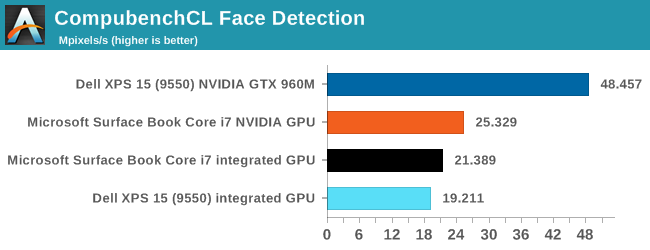
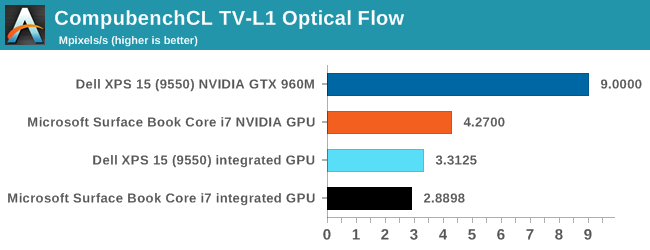
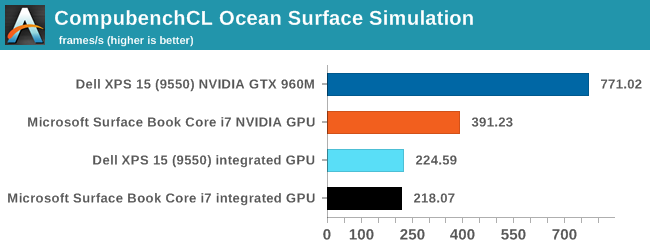
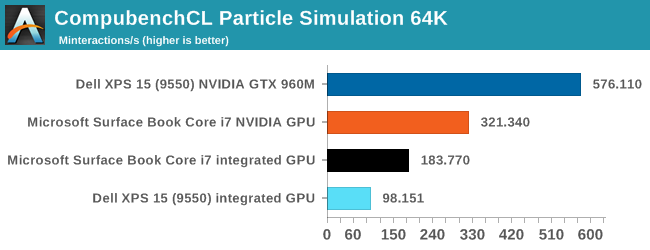
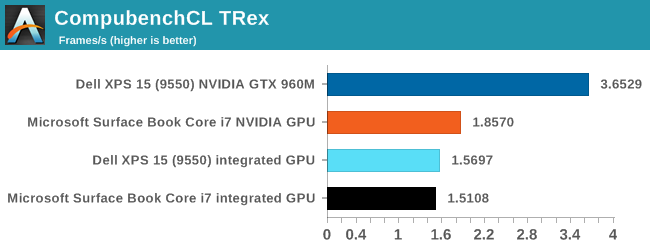

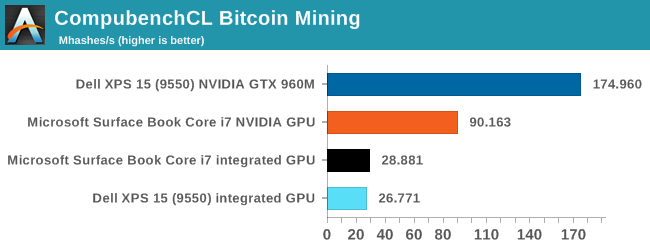
The only other device we’ve tested with Kishonti’s CompuBench is the dGPU version of the Surface Book. I felt it would be a nice comparison to see just how much more performance the GTX 960M would give in compute tasks. Compared to just integrated graphics, there is a big jump in performance from both of the discrete cards, but the GTX 960M is roughly double the performance of the GT 940M in the Surface Book. If you need compute power, you get a lot more in the XPS 15 with the quad-core processor and much more powerful GPU.
Storage Performance
Dell does offer the XPS 15 with a mechanical hard drive as the baseline option, but once you step up a couple of tiers it can be outfitted with a PCIe based SSD, and in the case of our review unit it is the Samsung PM951. This has become incredibly popular it seems, since it lets companies check the box beside PCIe on storage, but unfortunately it is a TLC based drive so write speeds aren't as high as what we've seen MLC-based PCIe drives do. Clearly Samsung is aggressive with the pricing on this drive since it is in pretty much every device we’ve seen that has PCIe storage.
Recently PCMark 8 updated their testing for storage to better differentiate drives with NVMe storage. As such, the existing scores are no longer comparable with those from the new suite. The XPS 15 scored 5036 in the new test, but we'll need more devices tested in order to have something to compare it to.
Despite the TLC NAND, Dell shipped the 512 GB version of the XPS 15, so it has enough NAND dies to help the write speeds through parallel work, keeping even this slower TLC drive performant over short bursts. I actually expected read speeds to be a bit higher as well but over 800 MB/s is still faster than what SATA drives can do.


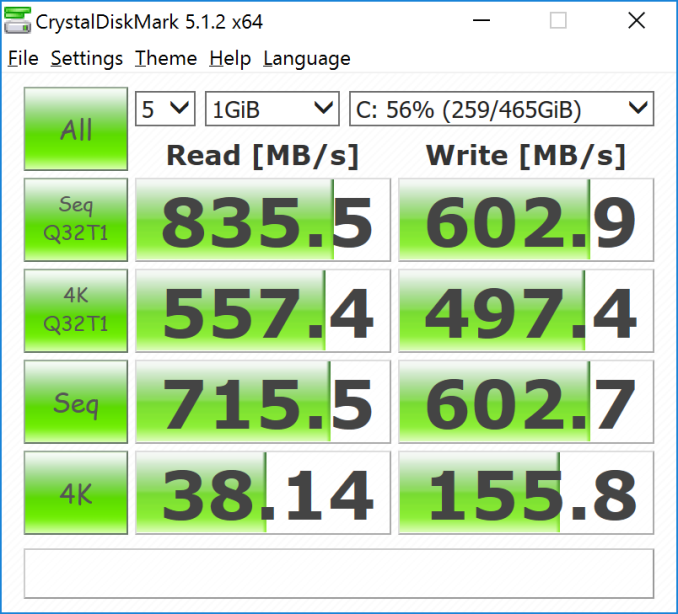








152 Comments
View All Comments
Brett Howse - Monday, March 7, 2016 - link
The extra half pound is the larger battery, which takes up the space of the 2.5" hard drive bay. If you get the large battery you can't get the HDD.doubledeej - Saturday, March 5, 2016 - link
Dell lost me as a customer when they started removing the dedicated Home, End, PageUp, and PageDown keys from their keyboard. It makes their laptops next to impossible to use productively for writing code or documents, which is about all I do these days.arswihart - Saturday, March 5, 2016 - link
I have this laptop, it's balls out, better display than Macbook Pro, light as a first-generation 13" ultrabook. Don't care about key travel, touch pad works great, beautiful to behold.nerd1 - Saturday, March 5, 2016 - link
Key travel is clearly worse than older XPS series and thinkpads, but about the same as macbook retina (and way better than new apple wireless keyboard for DESKTOP)People seem to adapt to absolute miserable key travel of new macbook/ipad pro anyway.
Notmyusualid - Sunday, March 6, 2016 - link
Sorry if I missed it.Name the wireless card please...
Much appreciated.
Notmyusualid - Sunday, March 6, 2016 - link
No worries, found it:BCM43602.
Someone out there is reporting that the connector sizes do not match existing wifi cards.
Pulled a 7260 from my AW18, and was hoping to finally find an upgrade to my trusty 6300N, which blows the newer .ac card out the window (for range).
Oh well.
Xajel - Sunday, March 6, 2016 - link
Hmmmm, I was off-listing Dell from my list of laptop options mainly duo to their chargers ( that weak data pin+wire which tends to fail and stops the laptop from charging while the charger is still working )... but this laptop is good I see, I might live with that charger thing but I have two things...I believe the laptop can be configured with the 1080p panel, so it will be better in terms of battery life. but AFAIK the 4K panel is superior in terms of picture quality which I prefer over half hour battery life specially that the 4K panel will have some DPI issues also...
But I would love to see a repetition of the display tests but for the 1080p panel to see the difference... the other thing I would like to know is the Type-C port, I believe the article mentioned it capable of power delivery also... does this mean that we can charge the laptop also ? if true then is the original charger 90W or 120W ? I'm asking this coz the Type-C spec. can handle up to 100W so if the laptop require a 90W charger then it won't be a problem, but if it requires 120W charger then charging will be a little slower ( unless the laptop was idle or turned off )
In all cases -even with slower charging- I prefer a standard Type-C charging solution over proprietary one, specially the famous faulty Dell chargers...
Brett Howse - Monday, March 7, 2016 - link
Yes you can charge over the Type-C. The power adapter size is listed in the specs but it's a 130w version, so over Type-C it would charge a bit slower.Ryan Smith - Monday, March 7, 2016 - link
Aye. If it can even accept 20V over Type-C, that still maxes out at 5A @ 20V, for 100W.Soac - Sunday, March 6, 2016 - link
The CrystalDiskMark READ scores are not correct. The Laptop comes setup in RAID mode for some strange reason... When switched to AHCI mode, the Reads go up to 1.7Gbps. I have the 512GB PM951. I would advise checking this out.